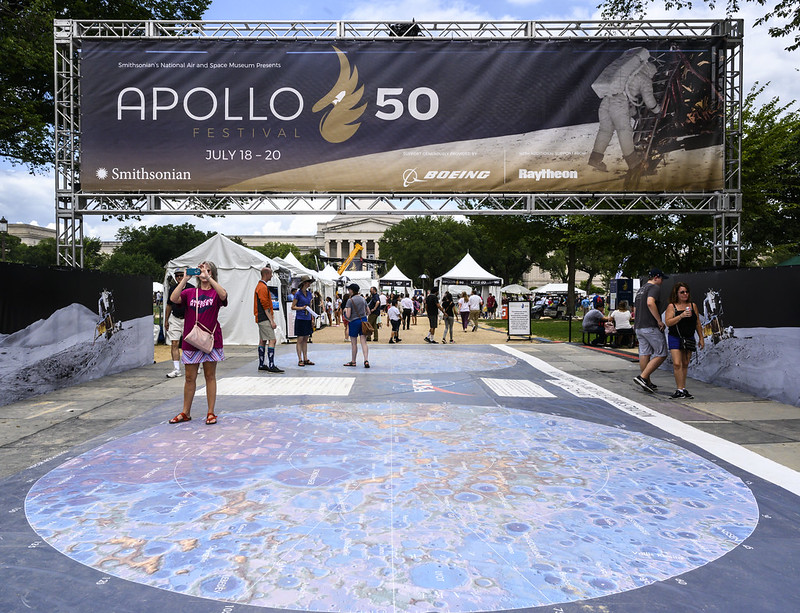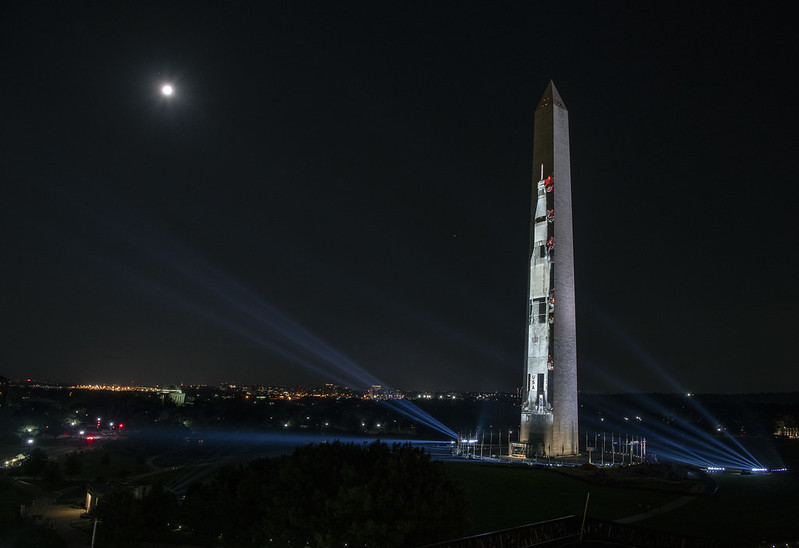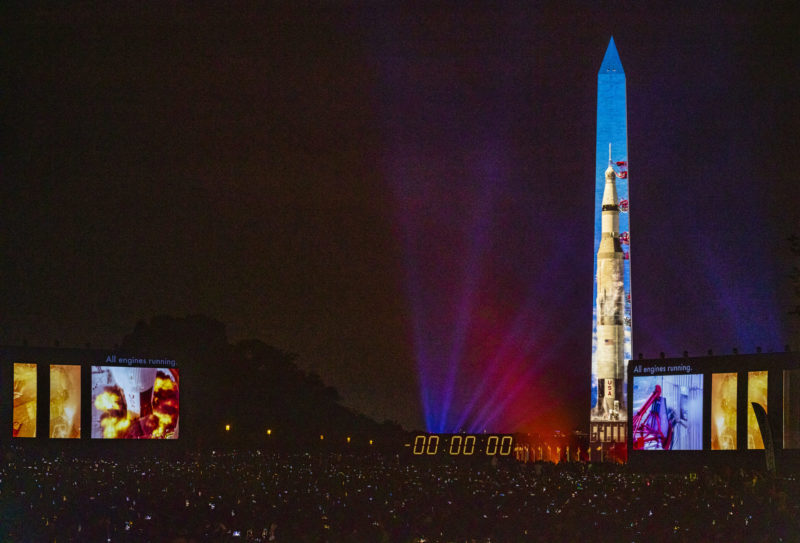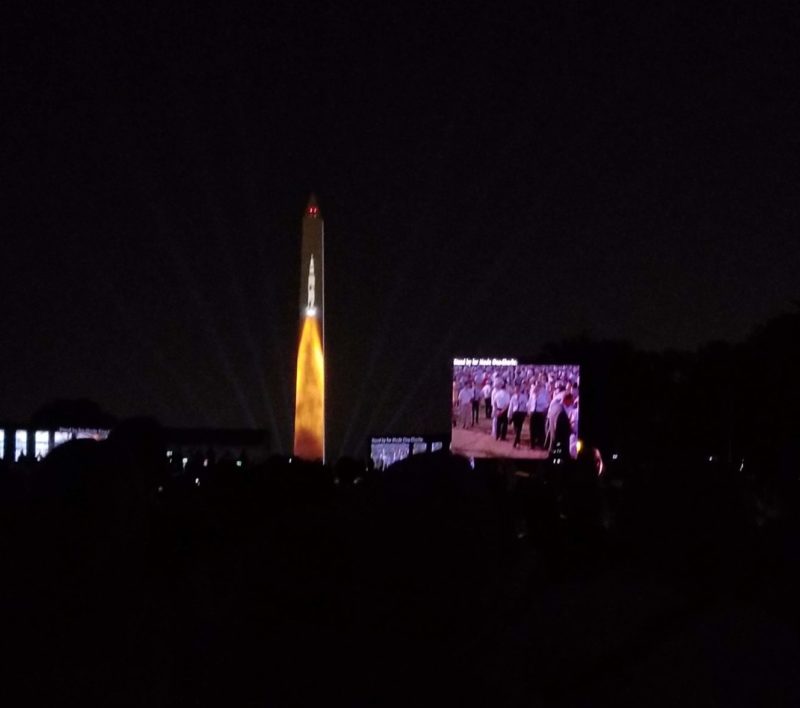Go For the Moon: Building Complex Public History Projects
09 April 2020 – Priya Chhaya
Last July, Washington, D.C. area visitors and residents were treated to an incredible sight: an image of the Saturn V rocket from the 1969 Apollo 11 mission that first put humans on the moon, projected onto the Washington Monument. This projection, known as Apollo 50: Go for the Moon, was a part of the commemoration of the 50th anniversary of the first moon landing, organized by the Smithsonian Institution’s National Air and Space Museum (NASM), that featured a weeklong series of events. In addition to the projection, the celebration included more traditional museum fare (lectures and activities in the museum, for instance). All of these events culminated in one of the most incredible public history experiences of my life.

The entrance to the Apollo 50 Festival on the National Mall across from the National Air and Space Museum in Washington, D.C., July 18, 2019. Photo Credit: Smithsonian National Air and Space Museum (photo by Jim Preston)
Picture this. Over the course of two nights, more than half a million people would sit between the Smithsonian Museums on the National Mall to watch a 17-minute program that combined projection mapping (the act of turning unusually shaped places into surfaces for projection) onto the Washington Monument with archival audio and video footage to bring the 1969 moon landing to 2019. During the event audiences would be treated to a multi-layered approach to storytelling—one that engaged a variety of senses through a theatrical presentation rarely seen on this scale. On one hand, the experience was historical in nature; we listened to the words of President John F. Kennedy in 1962 at Rice University and then saw real archival footage of crowds watching the launch of the Saturn V rocket. On the other hand, because of our place in time, we saw these two threads converge in a very ahistorical way, with two sources years apart in time converging to add meaning and emotional resonance to a significant moment in American history.
Many people were behind the execution of the project, but Go For the Moon was the brainchild of two staff members at NASM, Katherine Moyer and Nicholas Partridge. Last Fall, I spoke to them about the process of developing this project, and how a casual reference to the fact that the height of the Saturn V Rocket was roughly the size of the Washington Monument led to this awe-inspiring multimedia history experience. As part of that conversation, we discussed the importance of intention and the role that transformational partnerships played in the production of this remarkable event.
Setting Your Intention
Perhaps the most important component of any project is setting an intention (having an underlying mission that helps form your objective), a reason why a project at this scale is necessary. In the case of Go For the Moon, Moyer and Partridge (and NASM) recognized the opportunity that the 50th anniversary presented. Millions of people who were not yet living when the event occurred would be marking the occasion, as would millions of people who followed the launch in person and on television. The organizers saw this as an opportunity to have, as Partridge says, “a cross-generational conversation” about what that moment felt like and what it meant to those who witnessed it. To that end, it was also imperative, Partridge explained, to create a moment that acknowledged how “landing on the moon felt inevitable in hindsight, [but] we wanted it to feel impossible for a few minutes. So people understood what was at stake.”

The Washington Monument lit up with a projection of the Saturn V rocket that took the Apollo 11 crew to the moon 50 years ago. Photo Credit: Smithsonian National Air and Space Museum (photo by Jim Preston)
As public historians, we spend a lot of our time trying to make this connection between the past and audiences firmly rooted in the present. At historic sites, this is often done through the power of place. Go For the Moon was no different. In choosing to host this event on the National Mall NASM hoped that participants would feel the same sense of place, using the feeling of pageantry and emotion that the mall evokes to further ground the experience for visitors. In short, they wanted to take visitors back through time. Moyer and Partridge emphasized to me that it is easy to get information about the Moon Landing, since it was one of the most recorded events in American history (i.e. if you want information on the Moon Landing there are books, films, interviews about the event). However, Partridge states that “[the question is] how many books do you have to read in order to get that [sense of drama], and could we do it at a large enough scale so that people would feel the emotion we wanted them to feel about the story.” Moyer continues, “We almost wanted to suspend reality for that 17 minutes and tell the story like it was actually happening, and give the people the feeling of ‘is this actually going to happen.’”
By setting a clear purpose, the NASM focused on which parts of the story would be conveyed through this particular event: an intangible sense of being a part of something bigger than yourself. This is incredibly hard to orchestrate. As Moyer stated in our interview, it was only possible through successful partnerships.
Trust and Transformational Partnerships
Like with any program of this magnitude, Go For the Moon was not the work of just Moyer, Partridge, and the many other staff members at the NASM. Throughout our conversation, they emphasized how the genius behind the actual July 2019 production came from the brilliant minds at 59 Productions (the company responsible for elements of the 2012 London Olympics opening ceremony). While Moyer, Partridge, and the NASM brought with them the idea of projecting the Saturn V onto the Washington Monument, it was this particular partnership that made the event extraordinary.

The scene on the National Mall as the countdown goes to zero during the Apollo 50: Go for the Moon show, July 20, 2019. Photo credit: Smithsonian National Air and Space Museum (photo by Benjamin G. Sullivan)
Critical to the relationship between NASM and the production team was a level of trust. The NASM staff saw each piece of the production as it was put together: the animation, the use of John F. Kennedy’s 1962 speech, newly composed music by Jeff Beal (the composer who wrote the score for House of Cards), and lighting design. But because of the way projection mapping shows are developed and rehearsed, they did not truly see the final production until the event began. Partridge admits that “there were a lot of moments where [we] were daunted by the complexity. We always knew this was worth doing, but there were moments where we worried that secretly we wouldn’t feel the way we wanted the audience to feel. There were moments when we [would] say there’s just something missing, but it’s because we weren’t seeing it together.”
In a sense, this is a matter of sharing authority. While NASM were the content experts, they understood that the strength of this project lay in the translation between subject matter and storytelling techniques. Sometimes it is essential to cede some level of control in order to produce something unexpected. Moyer explained how critical this relationship was to the project: “None of this would have been possible without [59 productions]. The premise of [transformational partnerships] is to find someone who isn’t within your sector, but is doing the best possible work in their sector and together you do something that neither party could have done [alone]”.
Logistics
The final piece of the puzzle was logistics. This is not something new to those of us who design and implement public programming, but in the case of Go for the Moon it was a complicated process that was accomplished in partnership with the Department of the Interior and the Washington, D.C., government.
There were a number of hurdles that needed to be scaled. How could they best load in all the equipment and infrastructure needed? How could they keep the program content a secret while testing a structure that can literally be seen for miles? How late could they begin the program, with dusk in July not occurring until around 9:00pm? How many viewings would they do? With the event happening in the tourist core of Washington, D.C., what were the security and public transportation considerations? Were road closures necessary? How would they handle VIPs and distinguished guests? What would happen if it rained? Were there sound restrictions?

The view from the National Mall of Apollo 50: Go For the Moon. Photo credit: Priya Chhaya
In the end they decided on six showings over two nights. On July 19 and 20th, 2019, all of this looked effortless. Even the organizers didn’t know how well it would work until they experienced it themselves. For Moyer and Partridge there was an overwhelming sense of relief that they had succeeded.
Apollo 50: Go for the Moon was a spectacular piece of historical storytelling. While it wasn’t something that conveyed the traditional pieces of information about a historical event, it did something equally important: for 17 minutes, it took audiences to a moment when we all stopped and looked up at the stars, together.
~Priya Chhaya is the associate director of content at the National Trust for Historic Preservation. A public historian by training, you can follow her on Twitter @priyastoric and learn more about her work at www.priyachhaya.com.



